Summer Study: What Do Phase I Scholars Do?
This year, DO‑IT Phase I Scholars participated in a three-week Summer Study session. They learned about college life; explored online resources; interacted with peers, staff, and mentors; and had fun. The DO‑IT Scholars program started in 1993 as an experimental project for teens with disabilities nationwide. While it is usually held on campus at the University of Washington, this year it was held online. It is currently open to Washington State teens and is supported by the State of Washington. The DO-IT Scholars program is supported by all DO-IT staff and led by Tami Tidwell, Kayla Brown, and Andrea Mano.
NOTE: We had so many amazing articles this year from Scholars, we are sharing more in our next issue!
Empowerment Through Assistive Technologies
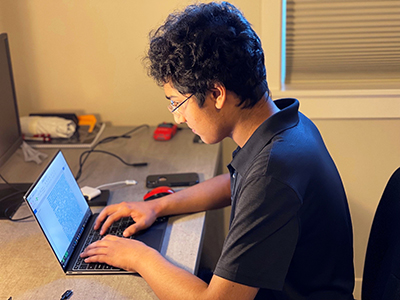
“For most of us, technology makes things easier. For a person with a disability, it makes things possible.” by Judy Heumann, American Disability Rights Activist and Former US Assistant Secretary
While in high school, I often wondered about the challenges I would face in college; some tasks that come naturally for others, are sometimes harder for me. For example, I can struggle with taking notes while trying to follow along. I sometimes have trouble focusing on the teacher in class while also capturing notes, and this ends up affecting my understanding of the concepts being discussed.
DO-IT introduced me to assistive technologies such as Sonocent Audio Notetaker, Inspiration graphic organizer software, and Moleskine Smart Pen, which opened me up to a world of opportunities. Sonocent is a note-taking software that allows students to understand lectures and discussions more effectively. I have used the Sonocent audio notetaker during my lectures at DO-IT and was able to focus on the important parts of the lecture while the software captured audio notes for me to review later. Inspiration helped me to be more organized and accomplish a specific task by using concept maps, mind maps, diagrams, graphic organizers, outlines, and presentations. I learned that the Moleskine Smart Pen allows me to amplify my handwritten ideas using digital technology. It helps me transfer words, graphics, ideas, and events directly to my smartphone, tablet or PC. These three assistive technologies can really help me overcome some of the key challenges that inhibit my learning.
My experience at DO-IT also made me curious about other assistive technology gadgets and software that are available. Some research on the internet made me aware of a number of excellent gadgets and tools and the ones that stood out for me are the AV1 Robot, MathTalk, Liftware, and Talkitt. The AV1 Robot acts as the student’s voice and ears if they miss school due to a long absence, and makes it possible to receive education being taught in class from home through an app on a tablet or smartphone. The AV1 also enables the child to stay socially connected with friends, and also take part in different school activities on their own time. Since I like mathematics, I found MathTalk to be an interesting piece of assistive technology. MathTalk allows the user to voice all types of math from algebra, pre-algebra, calculus, trigonometry, graphs, and statistics. The software enables physically challenged professionals, teachers, and students to voice out math without having to use a keyboard. The user can print out math work, and learn to speak distinctly and clearly. Another piece of technology that intrigued me was Liftware. Liftware helps people with motor disabilities to stabilize and reduce spilling of contents while eating. Liftware acts as a self-stabilizing handle that’s attached to the eating utensil—like a spoon or fork—thereby reducing shaking. One final piece of great assistive technology I learned about was Talkitt. The Talkitt app helps people with language and speech disorders to communicate more effectively with others. It translates difficult-to-understand pronunciation and spoken words into understandable speech, making it caregivers and others around the user easier to understand.
I’m really passionate about technology and would love to have a positive impact on the world. As part of my experience at DO-IT, it was really inspiring to see how technology—specifically assistive technology—can empower us and change lives.
Week One Hobby and Movie Nights
On Tuesday evening, we had a hobby night where a handful of Scholars and staff got together on Zoom to show off our hobbies. Of the people who showed up, most had a hobby related to art, one Scholar sang and I presented some of my models made out of thin sheets of steel. It was interesting to see what people presented.
On Wednesday evening, we had movie night. The selected movie was Star Wars: A New Hope, which was a movie that I suggested. We watched the movie over Zoom, and I was surprised that the quality was better than I expected. I’m used to using my iPad for Zoom, which does not seem to stream video very well—I would not recommend using one to watch even short videos over Zoom. This was the first time in over a decade that I got to watch A New Hope, and I highly enjoyed it.
Why Autistic People are Drawn to Anime
Autism, or autism spectrum disorder (ASD), refers to a broad range of conditions characterized by challenges with social skills, repetitive behaviors, speech, and nonverbal communication. According to the Centers for Disease Control, Autism affects 1 in 54 children in the United States today. There is no one type of autism—it’s not called a spectrum for nothing! Some people with ASD may require significant support in their daily lives, while others may need less support, and in some cases, live entirely independently. In spite of stereotypes, some people with autism may be very social, but have difficulty understanding other people’s viewpoints or interpreting their behavior. Many people with autism also have difficulty dealing with certain sensations (loud noise, bad smell, strong taste, rough textures). People with autism also often have “special interests” that they focus on and want to share with other people.
I believe most autistic people like anime because it often exaggerates the characters, making their intentions very clear and not leaving anything out. When you have a hard time interpreting what people are doing and why, anime doesn’t leave you guessing! Anime also has a wide range of interesting characters, many of whom share traits that many autistic people recognize in themselves. It is exciting when you see your disability (or features of it) represented in a positive and interesting way.
Some examples of anime characters with autism include Sai from Naruto Shippuden, Nagisa Furukawa from Clannad, Shiina Mashiro from Sakurasou No Pet Na Kanjo, L from Death Note, Mei Hatsume from My Hero Academia, and Felli Loss from Chrome Shelled Regios. Many of these characters exist in their own world, are obsessed with their specific interests, or need tips and tricks to communicate and make friends with neurotypical people.
Sai was the first autistic anime character I ever really connected with, because he is so open about what he does or does not understand in social situations. I related so much to him! Anime provides this avenue for people with autism to more easily connect with a variety of characters, and for differences to be seen as normal. All people with autism deserve acceptance because they are all beautiful, whether they are fictional or real.
Hard Worker and Learner
My name is Deliah, and I attended the DO‑IT Summer Study Program. I loved studying and learning new ideas from this program; however, I also had to work this summer.
I work at Subway; it’s near the highway, so it’s usually busy. This can leave me constantly drained of energy. When Tami notified me I was in the program and that it was going to be online, I quickly decided I would figure out a way to work and still participate and be active in DO-IT classes.
I told my manager my schedule for the Summer Study and then emailed Tami with which days and times I needed to work. At first I thought it would be difficult to sort out my hours, but it made me very gleeful that they accepted my given times, which let me plan ahead! I also made sure to remind the DO-IT staff before I left for work.
Going to work and participating in Summer Study ended up being easier to balance than I imagined thanks to the accommodations given to me from both my boss and DO-IT!
DO-IT Opportunities and Experiences
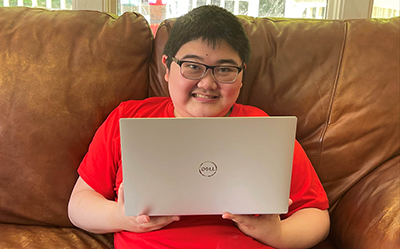
During DO-IT Summer Study classes, I have learned many skills including web design, communication, and college life preparation. For example, what I learned about college life preparation is that you have to learn skills on your own in order to find a successful life in college, and that you must advocate for yourself.
The most exciting thing I experienced in the DO-IT program was meeting people who have similar interests. The most challenging part of the DO-IT program to me was developing codes for website design. Specifically, I added details to the About HTML page, Evening HTML page, Newsletter HTML page, Photo Gallery HTML page, Meet Our Scholars HTML page, Contact Us HTML page, and created a section heading. I also developed my own personal web page using Visual Studio Code. I am passionate about coding that will benefit people’s access and make life easier for them. Regardless of the background and physical conditions of the individual, coding can make everyone’s dream come true.
I am so thankful for the opportunities and experience I have received from the DO-IT Scholars program. They will enable me to succeed in college academically and socially.
My Life with Multiple Disabilities
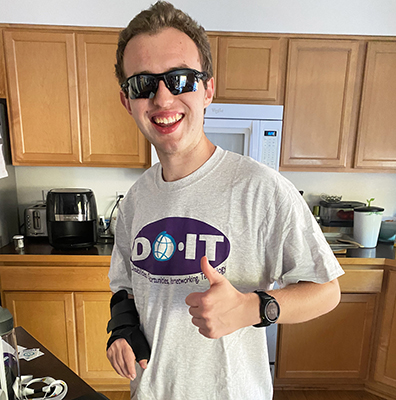
Low Vision
When I was around 11 years old, we discovered that I had significant vision loss. I started using accessibility products for people with low vision, but originally refused to use a mobility cane because I didn’t think I needed one—I was used to how I saw and traversed the world. I didn’t use one until I was 15 and I received an assessment that recommended that I use one. At first I was unsure, but I decided to be optimistic and at least try out the idea of using a cane. So, I gave it a try. The first place I went to try out the cane was the mall because I thought that would be busy and an excellent chance to see how people reacted to the cane and how I felt about it in the large crowds. I couldn’t believe the benefits I experienced from using it. I was less stressed, and was even able to enjoy myself. So, now I use a cane whenever I am out in public.
Cerebral Palsy
I have cerebral palsy as a result of a stroke in the womb. I would say that this disability has impacted my life the most, but it is also the one that I forget about more often because I’m so used to adapting to anything in my life. Some things I have adapted to doing “differently” than most people are putting on a shirt, tying my shoes, and washing my hands. I also wear orthotics that help my mobility so I can move without pain. DO-IT Summer Study has helped me a lot with my disabilities from the technology and the support they have given me so far.
Epilepsy
I also have partial company seizures, which means I have non-convulsive seizures. So if you see me having a seizure, I would just look like I am staring off into space. I have small seizures almost every day but about once a month I have a more intense seizure where my vision goes out and I am unaware of anything for about 2 to 3 minutes. Someone usually leads me to the couch or my bed and I lie down for about an hour. After that I am usually fully recovered and ready to go on with the day.
In conclusion, the disabilities I have are quite significant, but I have learned to adapt to them since they are the only life I know!
Getting Snacks in the Mail!
Have you ever wanted to get a box of snacks sent to you for free? It’s fun, exciting, and you get to eat! Snack boxes are an exciting part of Summer Study because you get to pick what you want, get a package in the mail, and then eat all the snacks!
The first reason why snack boxes are fun is being able to pick out what you want. Once you get onto the website, there are different snack topics like beverages, pantry items, crunchy snacks, and more. When clicking on the item you want, there should be an add to cart button. When you’re done finding all the snacks you want, there is a checkout button—we got to pay with credit from the Scholars program. It was exciting to get the confirmation email from UPS and get a tracking number. You then can look forward to your snack box!
The second reason why snack boxes are exciting is getting the package in the mail. After you pick out your snacks, the UPS company will label your package and send it off. After a few days, it arrives in the mail—then you are free to open your box of snacks.
The last reason why snack boxes are great is the eating. After opening the box of snacks you can eat to your heart’s content. How’s your box of snacks? You’re probably thinking it was fun, exciting, and—the best part—delicious.
The DO-IT Talent Show
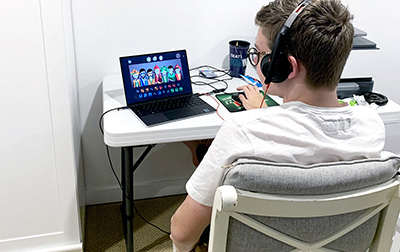
The DO-IT Talent Show was a great event. There were many participants showing many talents, not to mention all the fun the audience got to have watching them. There was music, poetry, and even a TikTok dance. I got to share my custom music, which I made using a music-making application called Incredibox. My music is an ode to various genres coming out of Brazilian and Indian culture. I also had enough time at the end of the Talent Show to showcase a second song. I also really enjoyed hearing the other talents, including piano playing and a custom poem. I highly recommend that others attend the Talent Show to both see other participants’ talents and to show off your own.
How a Thousand Butterflies Ventured Out of My Stomach During Summer Study
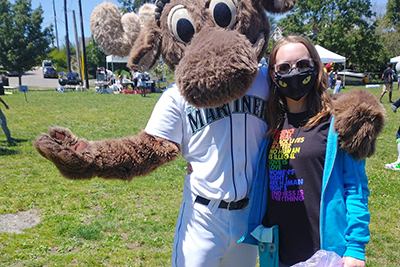
Did you know that anxiety disorders negatively affect thirty percent of adults in the United States, while they only affect eight percent of children and teenagers in the same country? I am a teenager with general anxiety disorder. Consequently, I generally have a difficult time getting used to new environments. However, my teachers and family members highly recommended that I participate in the DO-IT Scholars program so that I could find it easier to prepare for college. I have always wanted to go to college, but I have also always been extremely nervous to transition into adulthood. I feared that I would never become ready for all of the responsibilities that I need to take on in order to become successful as an adult. Nevertheless, when I got accepted into the DO-IT program, all of the staff supported me so much that I currently know much more about college than I did even a few weeks ago! This decreased my anxiety about needing to stay overnight away from my parents for so long. The DO-IT program has made fantastic progress in defeating my excessive anxiety about going to college.
I really enjoyed watching the movie called Fixed and discussing it with my peers. Here I learned that my disability should not stop me from being successful in college and beyond. When DO-IT staff member Kayla Brown showed the whole class Fixed, I immediately caught the premise of the movie—your disability makes you who you are and doesn’t need to be fixed! This premise sank into my soul so much that it played a major role in decreasing my anxiety about college.
Kayla and the movie both presented excellent explanations about the differences between the medical and social model of disability. Before I started the DO-IT program, I thought that only one model of disability existed. However, Kayla and Fixed both described how the medical model presented that “disability is a problem that exists within the person and the goal is to fix the person.” The medical model of disability was commonly used before the Americans with Disabilities Act of 1990 prohibited discrimination based on disability. Nevertheless, the presenter and movie both stated that the medical model of disability is largely obsolete. Accordingly, the medical model even showcases ableism, presenting people with disabilities as purely inspiration for people without disabilities. However, many Americans currently realize that the medical model of disability is incorrect.
Now, many people use the social model of disability. According to Kayla Brown, “the social model recognizes that disability and impairment are two different things. Disability is a social construct created by barriers within institutions, attitudes, stereotypes, and inequality.” The social model does not present any phenomena about needing to fix disabilities. Instead, the social model presents disabilities as deriving from and playing a major role in society. Consequently, learning about the social model helped me become less anxious about the life ahead of me because it made me realize that Americans are really improving when it comes to respecting people with disabilities. Therefore, in a lot of workplaces across the United States, the chance that I will be hired for a job will be similar to the chances that people without disabilities will get hired for that same job. This highly increases my confidences about my successes later in life.
Since this year’s DO-IT Summer Study was fully online, I knew that I could not spend my whole three weeks of summer study performing DO-IT related tasks. Therefore, I could finish all of my DO-IT related activities on time and still embark on local ventures that were not at all associated with DO-IT. I researched events that occurred within King County that I could attend with my mom. I found a super fun event where I met a whole bunch of Seattle sports-related characters and took selfies with them. This event occurred in South Seattle. After I met all of the characters, I made some pastel art for a nearby art club and got to watch various dance performances. This was one of the best ventures that I had gone on since before the pandemic! This experience showed me that I can still behave like a kid during my days off work as an adult. Since very few kid-friendly events occurred during the pandemic, I forgot that I could still embark on these kinds of kid-friendly ventures as an adult and not be judged for attending those events. I also got to spend an afternoon riding water slides at Wild Waves!
During the last few weeks, I have learned that even though I am super busy performing work-related tasks so frequently, I can still make time to embark on super fun adventures! Moreover, I have learned that DO-IT can help me succeed in college and beyond!